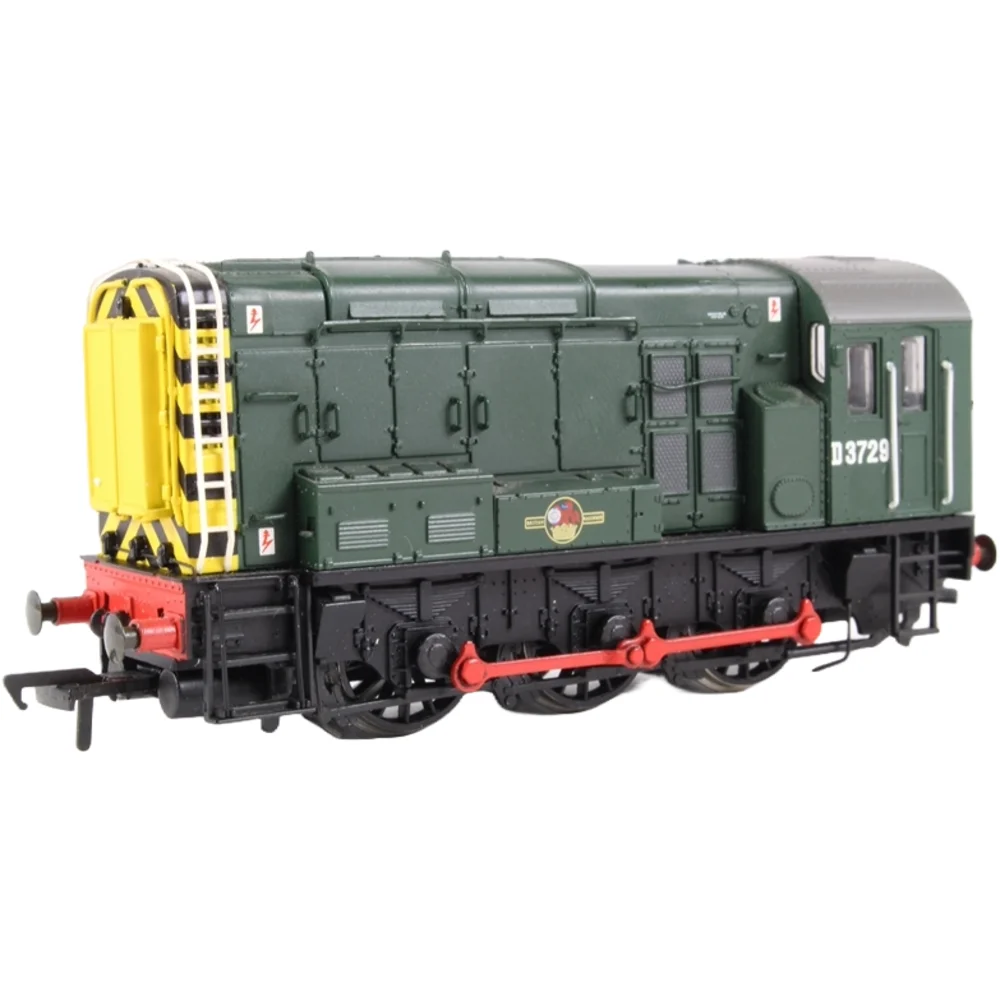Bachmann 32-101
British Rail Class 08 D3729 British Railways Green with Late Crest
Tooling
In 2000, Bachmann introduced its first entirely new OO-scale tooling for the iconic British Rail Class 08 0-6-0 diesel-electric shunters. Released under the “Blue Riband” / Branchline range, the new tooling marked a significant improvement over earlier offerings in terms of accuracy, build quality, and performance standards for mainstream British-outline models.
Tooling Features
- Scale & Construction: Precision injection-moulded body shell, die-cast metal chassis and weight, metal grab handles, etched cab and body details.
- Detail Variants: Multiple configurable parts including lamp brackets, buffer types, radiator access ladders, cab door styles (steel/wood), compressor boxes, and varied roof vents to accurately represent individual prototype variations.
- Couplings: Standard NEM tension-lock couplings in early releases; some later variants (post-sound versions) introduced optional auto-release couplings, although not part of the original tooling.
Mechanical & Electrical Performance
- Drivetrain: Five-pole motor with substantial flywheel, driving the rear axle through precise gearing; achieves excellent slow-speed control and real-world haulage capability.
- Chassis: Sprung centre axle enhances tracking on uneven or flexible track; all-wheel power pickup, with metal bearings on every axle.
- Minimum Radius: Suitable for standard OO tight radii, replicating prototype shunting performance.
- Weights: Metal construction contributes to robust, well-balanced feel and dependable traction.
- Lighting (Early Versions): Twin head/tail lamps at each end (analogue lighting configuration); cab light featured in later iterations.
DCC Capability
- Original tooling included provision for DCC conversion: factory-fitted decoder socket (PluX22) accessible via removable roof.
- Subsequent sound-fitted variants offered features like onboard speakers and stay-alive circuitry (“Bach-Up”) for flicker-free DCC operation, though these were deployed after the initial release.
Liveries Produced (Circa 2000–2004)
Early tooling produced a variety of prototypical liveries reflective of the Class 08 lineup during that period, including:
- BR Blue with yellow ends
- BR Green (late crest version)
- Provincial and Railfreight sectors
- Preservation liveries featured on early preserved examples
Reception and Reviews
The tooling set a new benchmark for Bachmann’s British-outline releases. Model Rail’s August 2025 retrospective identified the tooling’s debut as an “epochal moment,” praising its superior running smoothness and detailing compared to both Bachmann’s own legacy offerings and its competitors. Key Model World’s 2024 preview highlighted the full-suite lighting potential, stay-alive readiness, and robust chassis construction. Overall, reviews confirmed that the tooling delivered both in aesthetic fidelity and reliable operation.
Media & Online Commentary
- Online forums (e.g., RMweb) regularly discuss the tooling’s configurability, ease of DCC conversion via the removable roof, and accessory parts interchangeability; user reviews note the high quality of mouldings and low noise performance.
- YouTube unboxings and comparative reviews highlight the jump in detail and mechanical performance relative to earlier Bachmann Class 08 models, with particular praise for the clean motion of coupling rods and gearbox resilience.
Interesting Insights
- The modular design enabled Bachmann to issue a wide variety of accurate prototype versions without needing separate body shells—only detail sprue variants.
- Decay-resistant plastic and die-cast parts have helped maintain valued collectibility and running longevity over time.
- The inclusion of DCC-friendly features in the original tooling—rare for early 2000s models—speaks to foresight in embracing digital control trends.
Conclusion
Bachmann’s 2000 tooling of the Class 08 firmly raised expectations for OO-scale diesel shunters. With verifiable mechanical excellence and thoughtful detail accuracy, it quickly became a favourite among collectors and operators. Its flexible tooling suite, DCC-ready features, and strong media reception validated its status as a pivotal release—providing a solid foundation for the later 2005 retooling.
Class & Prototype
- Class: British Rail Class 08
- Traction: Diesel
- Transmission: Electric
- Built: 1952-1962
- Total Built: 996
The British Rail Class 08 diesel-electric shunter represents Britain's most numerous locomotive class with 996 built 1952-1962. Powered by the reliable English Electric 6KT diesel engine producing 350-400hp, these 0-6-0 yard locomotives continue working after seven decades, with 100-170 still in active service alongside 87 preserved examples. The Class 08's universal deployment across freight yards, passenger stations, and industrial sidings from 1953 to present makes it the most versatile British diesel for model railway layouts.
- Running Number: D3729
- Name: -
- Ordered By: British Railways
- Built By: British Railways
- Built At: Crewe
- Built: 01/1959
- Withdrawn: 01/1994
- Length of Service: 35.0 years
- Running Numbers: BR D3729, BR 08562
- Names: -
Operator & Livery
- Operator: British Railways
- Livery: Green with Late Crest
British Railways transformed Britain's fragmented rail network into a unified national system following nationalisation on 1st January 1948. Created from the "Big Four" companies under the Transport Act 1947, BR operated most of Great Britain's railways until rebranding as British Rail in 1965, managing over 20,000 route miles and inheriting nearly 20,000 locomotives of diverse designs.
The organisation pioneered standardisation through its revolutionary BR Standard locomotive programme (1951-1960), producing 999 advanced steam engines under Robert Riddles' direction. These included the versatile Britannia Pacifics, mighty 9F freight engines, and mixed-traffic classes that incorporated the best features from all predecessor companies. The 1955 Modernisation Plan accelerated diesel and electric traction development, creating fascinating mixed-traction operations.
Notable achievements included establishing unified locomotive classification systems, introducing distinctive corporate liveries, and managing the complex transition from steam to modern traction. BR's six regional structure preserved operational diversity whilst enabling standardisation of practices, signalling, and rolling stock that had eluded private enterprise for over a century.
The BR era represents steam traction's final flowering alongside emerging diesel technology, creating unparalleled locomotive variety. Today, this heritage remains highly popular with railway enthusiasts through extensive preserved fleets, heritage railway operations, and comprehensive model ranges from manufacturers like Hornby, Bachmann, and Dapol, making BR subjects essential for authentic post-war British railway modelling across all scales.
